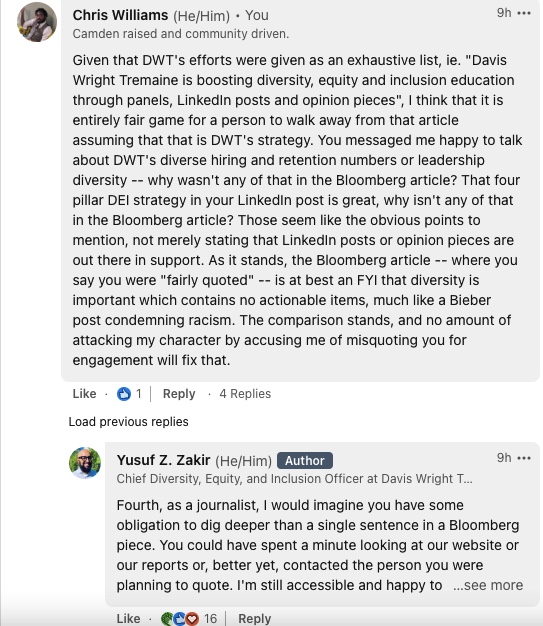
When you see someone advocating for diversity, they usually tie it with an actionable item. When Martin Luther King III and Al Sharpton met with Above the Law, we talked about the importance of diversity and planned to defend it by pressuring Biden to nominate more Black judges. When Kimberlé Crenshaw met with us to discuss the actual meaning of intersectionality and the fight to do damage control on right-wing misuses of it and the term “Critical Race Theory,” she asked readers to join in on the 3rd Annual Critical Race Theory Summer School so that they can learn about CRT while getting their CLEs. Unfortunately, things can’t always be that simple.
After the SFFA v. Harvard decision, law firms are more cautious about if and how they advocate for diversity, likely for fear of being sued. While understandable, that usually results in wishy-washy or non-committal platitudes about the importance of diversity with no clear discussion of the most vital part of advocacy: implementation. In short, you end up with all vibes and no process. This non-committal ethos also extends to how diversity efforts are discussed in public. For an example, here is a excerpt from a Bloomberg article titled Law Firms Boost Diversity Defenses After Conservative Backlash:
Law firms are actively defending diversity efforts after conservative attacks and a slowing economy threaten gains.
Davis Wright Tremaine is boosting diversity, equity and inclusion education through panels, LinkedIn posts and opinion pieces. “There’s more of a call to explain it,” Yusuf Zakir, the firm’s DEI chief, said in an interview.
Prior to SFFA, a firm “actively defending diversity efforts” would have looked like them mic dropping their well-funded summer associate program for Blacks and Latinos or bragging about the number of their Pacific Islander equity partners. Hell, Cooley put their money where their mouths were back in 2020 and donated $750k to Black Lives Matter “as part of a commitment to taking action to end systemic racism.” With these things in mind, framing the “call to explain” the attack on DEI and some opinion pieces as “actively defending diversity efforts” comes up short. I thought that this would be an uncontroversial position. I was wrong. Davis Wright Tremaine’s Chief of DEI Yusuf Zakir had this, among other things to say:
One of the risks of speaking up is that, sometimes, people find ways to mischaracterize what you say (and sometimes, they do this just to get a few extra clicks).
In this case, Chris Williams from Above the Law misinterpreted a quote of mine in his article.
In a thoughtful Bloomberg Law piece written by Tatyana Monnay, Tatyana asked me about what we were doing at Davis Wright Tremaine LLP in the face of anti-DEI backlash. We spent an hour talking, including a robust discussion of our DWT DEI strategy.
One of the things I said, which she fairly quoted me on, was that I was using different platforms (including LinkedIn and panels) to vocally advocate in support of DEI. In the face of the vocal anti-DEI backlash, I am compelled to be just as vocal in response. These are not the standard diversity debates of the past – these are existential. I told her this was taking up a larger portion of my time than before.
Chris took my quote to somehow imply that this was ALL we were doing at DWT on DEI. I’m not sure how he could jump to that conclusion from a sentence in the Bloomberg article, but he did. Based on his conclusion, he compared our efforts to the meme of Justin Bieber wearing a “Racism is Evil” sweatshirt (a snarky reference – credit for that).
For reference, this is what he’s responding to. Feels weird to quote myself, but c’est la vie:
… Actively defending diversity efforts with posts and panels? I’m gonna be honest with you — that just reads like the suit-and-tie version of this:
To the firms making concrete moves to develop DEI, that’s great. That said, diversity discussions have been ongoing for years now. At this point, you should lead with concrete actions and strategies being deployed, not by centering LinkedIn lessons and pro DEI articles.
Now, I like to throw out a spicy take every now and again, but I think that this is one of the tamest things I’ve ever said on the site that someone has had this adverse of a reaction to. As to DEI being great, I’ll just assume Zakir and I agree. As far as the timeline of these diversity discussions, here’s a law review article discussing the need for diversity in law firms from 1993 — that’s about 30 years ago for those of you who don’t want to break out their calculators. Is it really that bonkers to say, “Hey, we’ve done enough talking, let’s lead with the action items”? Because Stephen Miller and Edward Blum aren’t leading with LinkedIn articles about affirmative action being bad, they’re leading with lawsuits. And they are winning. You know, actionables! And when you do get a soundbite from one of the anti-DEI talking heads, it’s something that’s confrontational and easy to digest like Elon Musk saying “DEI is another word for racism,” not something that promises to address the issue at a later time like “We will cover it later on LinkedIn.” Is talking about DEI important? Yes. That’s why it is important to call out when pieces “actively defending” it use the Gnome plan for diversifying the field.
If you disagree, I welcome you to read the article and find the part that goes “Here’s the plan.” Take all the time you need.
Was my article an attack on Zakir or DWT? No, it was a critique of what counts as an “active defense of diversity,” a call to have some action items in your coverage, and a call for law firms to publicly implement actionable items that increase diversity at their firms. In case Zakir or anyone else didn’t make it to the bottom of the article where I said this, I’ll re-print it here:
If firms are going to start making trends of posting how important their diversity advocacy is, it better be tied to some concrete action. Make a post about some diverse hires. Name some diverse partners — actual partners, and not the glass ceiling that gets dressed up as non-equity partner. And for the love of all that is billable, throw some scholarships out there that match what you preach.
A person having a normal time of it would have said “Oh, my firm does that!” and went on their merry way. Instead, Zakir made a bunch of accusations about me missing the point. How he took my article to be an attack on him or his firm’s diversity efforts is beyond me. Maybe it’s easy to miss the point over the sound of your coworkers patting you on the back:

And the strangest thing? DWT actually has some infrastructure for fostering diversity in their firm — Zakir speaks at great length about the four pillars of Community, Growth, Education, and Engagement in his LinkedIn post. Now, is any of that in the Bloomberg article? No! Not a breath beyond “We need to explain more” came out of the hour-long interview he had prior to the article’s release, and that’s why at the end of the day he himself told me that the information I was looking for was elsewhere:

He probably should be mad at a journalist for undercutting DWT’s diversity efforts for clickbait or mischaracterizing the depth of his work, but it ain’t me.
Earlier: LinkedIn Activism Is Cool, But We’d Rather See You Actually Hire Diverse Applicants
 Chris Williams became a social media manager and assistant editor for Above the Law in June 2021. Prior to joining the staff, he moonlighted as a minor Memelord™ in the Facebook group Law School Memes for Edgy T14s. He endured Missouri long enough to graduate from Washington University in St. Louis School of Law. He is a former boatbuilder who cannot swim, a published author on critical race theory, philosophy, and humor, and has a love for cycling that occasionally annoys his peers. You can reach him by email at cwilliams@abovethelaw.com and by tweet at @WritesForRent.
Chris Williams became a social media manager and assistant editor for Above the Law in June 2021. Prior to joining the staff, he moonlighted as a minor Memelord™ in the Facebook group Law School Memes for Edgy T14s. He endured Missouri long enough to graduate from Washington University in St. Louis School of Law. He is a former boatbuilder who cannot swim, a published author on critical race theory, philosophy, and humor, and has a love for cycling that occasionally annoys his peers. You can reach him by email at cwilliams@abovethelaw.com and by tweet at @WritesForRent.

